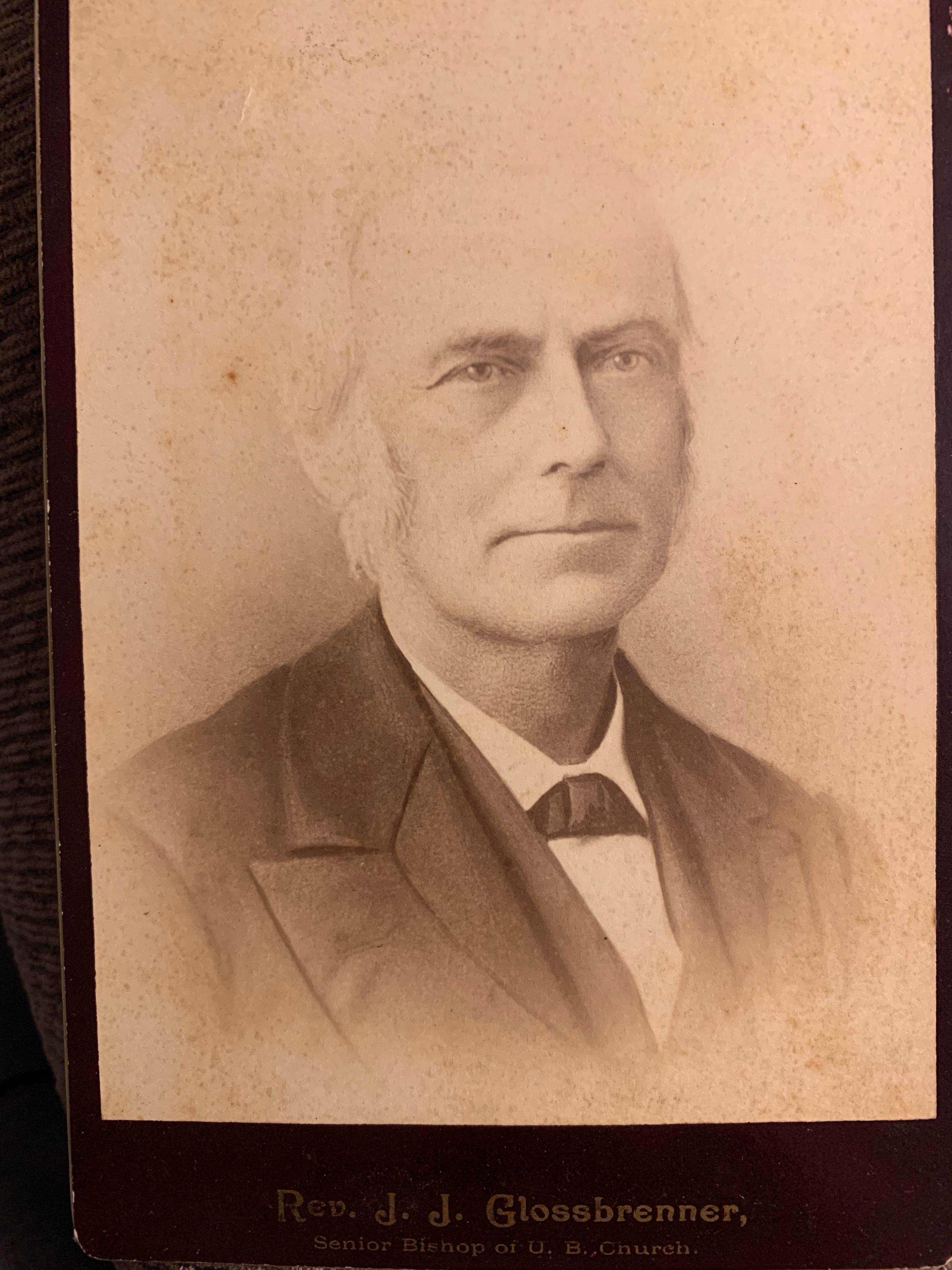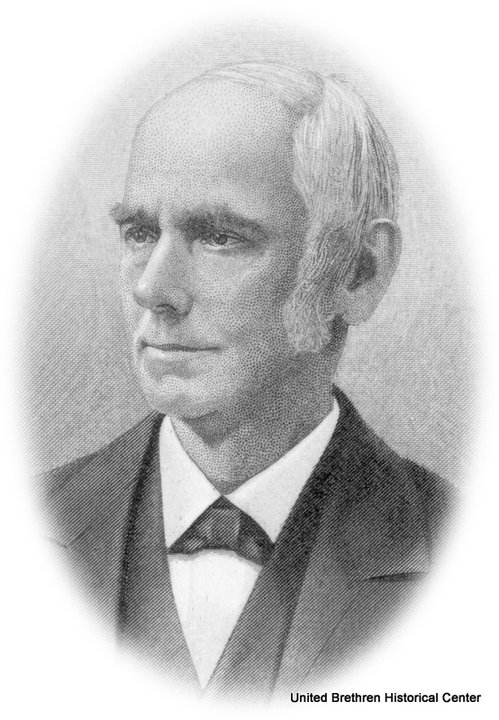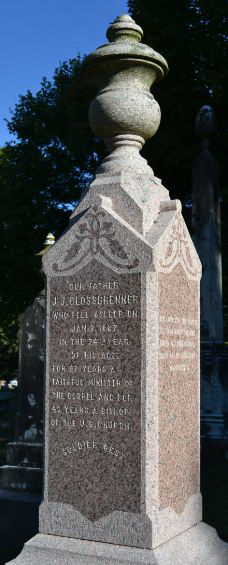Jacob had 2 brothers and 1 sister. He was a silversmith and a watchmaker, since the age of 14. He had a Lutheran background. He went to a private school.
On February 14, 1833 he married Maria M. Shuey. They had 6 daughters. One child died in infancy.
In the winter of 1829/1830 he was converted under the preaching of Rev. William R. Rhinehart. In 1830 he had his license to exhort, and in 1831, a license to preach, given by Bishop Geeting. He was ordained in the Virginia Conference in 1833. Bishop Kumler Sr. assisted by Rev. William Brown held the ordination service.
Almost all UB members in Virginia opposed slavery, but were basically cut off from the rest of the denomination. When the war started, some UBs suggested going independent and forming a southern United Brethren church.
However, Bishop Jacob John Glossbrenner decided to stay in Virginia throughout the war, and he was the glue of the Maryland and Virginia churches, part of the same conference, held separate annual conferences for the duration. Glossbrenner was allowed to pass through the battle lines to hold conference for the Maryland churches and then return to Virginia.
The 1865 General Conference met May 11, 1865, in Iowa, two days after Robert E. Lee surrendered to Ulysses S. Grant at Appomattox Courthouse. When news of the surrender reached the conference, there was much rejoicing and they broke out in the “Doxology.”
Bishop Glossbrenner was there. Some ministers initially treated him coldly, suspicious of his decision to spend the war in Confederate territory. But after hearing Glossbrenner’s story, delegates passed a resolution commending his heroic leadership of the Virginia churches during the war.
The Civil War, which United Brethren people generally viewed as a just war to end a great evil, prompted us to reconsider our 1849 statement which emphasized pacifism. The 1865 General Conference, while still opposing aggressive warfare, added, “We believe it to be entirely consistent with the spirit of Christianity to bear arms when called upon to do so by the properly constituted authorities of our government for its preservation and defense.”
By 1865, Glossbrenner had already served 20 years as bishop. He continued another 20 years. His 40 years as bishop is longer than any other bishop, ever. He died two years after leaving office, possibly of stomach cancer.
So Jacob did a lot of things during his tenure. One of which was organizing a conference in Canada. That happened on April 19, 1856. United Brethrenism in Canada developed in a hodgepodge sort of way, and involved an assortment of people.
A non-UB named John Cornell, from the “Cornell University” family, moved to Ontario in 1800 and spent the rest of his life as a preacher there. He started a number of churches. Jacob Erb, a United Brethren minister from Ohio, was sent by his home conference, Pennsylvania, as a missionary to Canada around 1825. He preached and scattered a lot of seed, but didn’t organize any churches. He went back and forth, but had a continuing relationship with Canada. Some UBs had apparently immigrated to Canada, because Newcomer mentioned meeting “many acquaintances whom I had not seen for many years.”
Which brings us back to John Cornell. In 1854, Cornell, now a 72-year-old, began considering retirement. What would become of his scattered congregations? He met with Jacob Erb, liked what he heard about the United Brethren church, and brought his churches under the UB umbrella.
Two years later, Bishop Glossbrenner officially organized the Canada Mission Conference. There were eight ordained ministers—four Americans, and four Canadians (including John Cornell and his son, William)—plus one other licensed minister. The minutes from 1856 showed 152 members among 18 preaching appointments and seven organized churches. Growth came quickly. By 1863, membership had hit 1000.
So, Canada owns two first: our first conference outside of the United States, and our first national conference. between 1834 and 1837. He was a minister for 56 years.
Jacob Glossbrenner was elected Bishop in 1845, and served until 1885, a total of 40 years. He was elected Bishop Emeritus.
His last years were spent visiting churches and speaking. He died of possible stomach cancer at about age 74.
Bishop Weaver preached at his funeral. Burial was in Green HIll Cemetery, Virginia.
Jacob John Glossbrenner, Bishop 1845-1885.
Bishop Glossbrenner used his 50th anniversary celebration to speak about four covenants he had made during his lifetime. He described them as four “marriages.” Here are excerpts as captured by historian A. W. Drury:
“My first solemn covenant was when I embraced Christ. Then I consented to live for Him and to die for Him. From Him I have not been separated. At 18, I embraced religion, and have no cause to regret it.
“The second covenant was when I became a member of the church. I have not felt like leaving the church. The church has been faithful to me. It is better to hold on to this covenant.
“The third marriage was when I took the vows of a Christian minister–when I consecrated myself to Christ fully. The church has branches. I joined with the United Brethren in Christ as a minister. The Church was then small. It was then weak. The Church has treated me well. In the church let me live; in the church let me labor; in the church let me suffer, if need be; in the church let me die, and stand at last with the white-robed throng of the church triumphant.
“The fourth union was marriage, the anniversary of which we today celebrate. It has not been broken these 50 years. These years have been spent in love and confidence. There are not many so favored.”
The Glossbrenners had six children; one died in infancy, but five daughters grew to adulthood. Three daughters married Lutheran ministers, and one died a year after marrying Rev. D. K. Flickinger, a future bishop and missionary to Sierra Leone.
During their latter years, both Jacob and Maria were very ill. At one point, they occupied sick beds in rooms across the hall from each other. A. W. Drury wrote, “Their spirits were so bound to each other that it seemed if one should be taken, the other could not be restrained from going also. It was uncertain which would be taken first.” Turned out to be Maria.
Bishop Glossbrenner’s health returned somewhat, and he continued in ministry to a limited extent until his death on January 7, 1887.
taken from the United Brethren history archives.
Jacob had 2 brothers and 1 sister. He was a silversmith and a watchmaker, since the age of 14. He had a Lutheran background. He went to a private school.
On February 14, 1833 he married Maria M. Shuey. They had 6 daughters. One child died in infancy.
In the winter of 1829/1830 he was converted under the preaching of Rev. William R. Rhinehart. In 1830 he had his license to exhort, and in 1831, a license to preach, given by Bishop Geeting. He was ordained in the Virginia Conference in 1833. Bishop Kumler Sr. assisted by Rev. William Brown held the ordination service.
Almost all UB members in Virginia opposed slavery, but were basically cut off from the rest of the denomination. When the war started, some UBs suggested going independent and forming a southern United Brethren church.
However, Bishop Jacob John Glossbrenner decided to stay in Virginia throughout the war, and he was the glue of the Maryland and Virginia churches, part of the same conference, held separate annual conferences for the duration. Glossbrenner was allowed to pass through the battle lines to hold conference for the Maryland churches and then return to Virginia.
The 1865 General Conference met May 11, 1865, in Iowa, two days after Robert E. Lee surrendered to Ulysses S. Grant at Appomattox Courthouse. When news of the surrender reached the conference, there was much rejoicing and they broke out in the “Doxology.”
Bishop Glossbrenner was there. Some ministers initially treated him coldly, suspicious of his decision to spend the war in Confederate territory. But after hearing Glossbrenner’s story, delegates passed a resolution commending his heroic leadership of the Virginia churches during the war.
The Civil War, which United Brethren people generally viewed as a just war to end a great evil, prompted us to reconsider our 1849 statement which emphasized pacifism. The 1865 General Conference, while still opposing aggressive warfare, added, “We believe it to be entirely consistent with the spirit of Christianity to bear arms when called upon to do so by the properly constituted authorities of our government for its preservation and defense.”
By 1865, Glossbrenner had already served 20 years as bishop. He continued another 20 years. His 40 years as bishop is longer than any other bishop, ever. He died two years after leaving office, possibly of stomach cancer.
So Jacob did a lot of things during his tenure. One of which was organizing a conference in Canada. That happened on April 19, 1856. United Brethrenism in Canada developed in a hodgepodge sort of way, and involved an assortment of people.
A non-UB named John Cornell, from the “Cornell University” family, moved to Ontario in 1800 and spent the rest of his life as a preacher there. He started a number of churches. Jacob Erb, a United Brethren minister from Ohio, was sent by his home conference, Pennsylvania, as a missionary to Canada around 1825. He preached and scattered a lot of seed, but didn’t organize any churches. He went back and forth, but had a continuing relationship with Canada. Some UBs had apparently immigrated to Canada, because Newcomer mentioned meeting “many acquaintances whom I had not seen for many years.”
Which brings us back to John Cornell. In 1854, Cornell, now a 72-year-old, began considering retirement. What would become of his scattered congregations? He met with Jacob Erb, liked what he heard about the United Brethren church, and brought his churches under the UB umbrella.
Two years later, Bishop Glossbrenner officially organized the Canada Mission Conference. There were eight ordained ministers—four Americans, and four Canadians (including John Cornell and his son, William)—plus one other licensed minister. The minutes from 1856 showed 152 members among 18 preaching appointments and seven organized churches. Growth came quickly. By 1863, membership had hit 1000.
So, Canada owns two first: our first conference outside of the United States, and our first national conference. between 1834 and 1837. He was a minister for 56 years.
Jacob Glossbrenner was elected Bishop in 1845, and served until 1885, a total of 40 years. He was elected Bishop Emeritus.
His last years were spent visiting churches and speaking. He died of possible stomach cancer at about age 74.
Bishop Weaver preached at his funeral. Burial was in Green HIll Cemetery, Virginia.
Jacob John Glossbrenner, Bishop 1845-1885.
Bishop Glossbrenner used his 50th anniversary celebration to speak about four covenants he had made during his lifetime. He described them as four “marriages.” Here are excerpts as captured by historian A. W. Drury:
“My first solemn covenant was when I embraced Christ. Then I consented to live for Him and to die for Him. From Him I have not been separated. At 18, I embraced religion, and have no cause to regret it.
“The second covenant was when I became a member of the church. I have not felt like leaving the church. The church has been faithful to me. It is better to hold on to this covenant.
“The third marriage was when I took the vows of a Christian minister–when I consecrated myself to Christ fully. The church has branches. I joined with the United Brethren in Christ as a minister. The Church was then small. It was then weak. The Church has treated me well. In the church let me live; in the church let me labor; in the church let me suffer, if need be; in the church let me die, and stand at last with the white-robed throng of the church triumphant.
“The fourth union was marriage, the anniversary of which we today celebrate. It has not been broken these 50 years. These years have been spent in love and confidence. There are not many so favored.”
The Glossbrenners had six children; one died in infancy, but five daughters grew to adulthood. Three daughters married Lutheran ministers, and one died a year after marrying Rev. D. K. Flickinger, a future bishop and missionary to Sierra Leone.
During their latter years, both Jacob and Maria were very ill. At one point, they occupied sick beds in rooms across the hall from each other. A. W. Drury wrote, “Their spirits were so bound to each other that it seemed if one should be taken, the other could not be restrained from going also. It was uncertain which would be taken first.” Turned out to be Maria.
Bishop Glossbrenner’s health returned somewhat, and he continued in ministry to a limited extent until his death on January 7, 1887.
taken from the United Brethren history archives.
Family Members
Advertisement
Records on Ancestry
Advertisement











